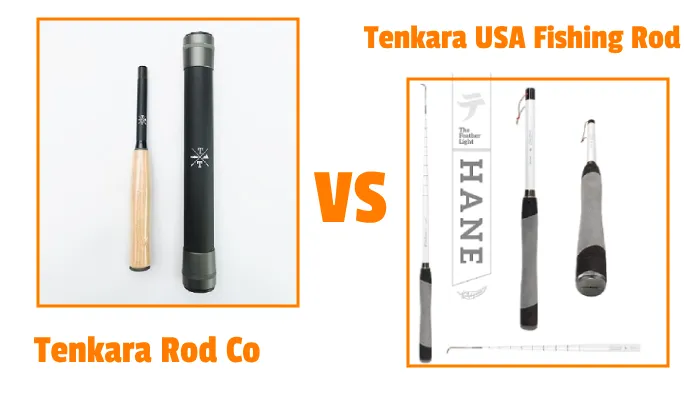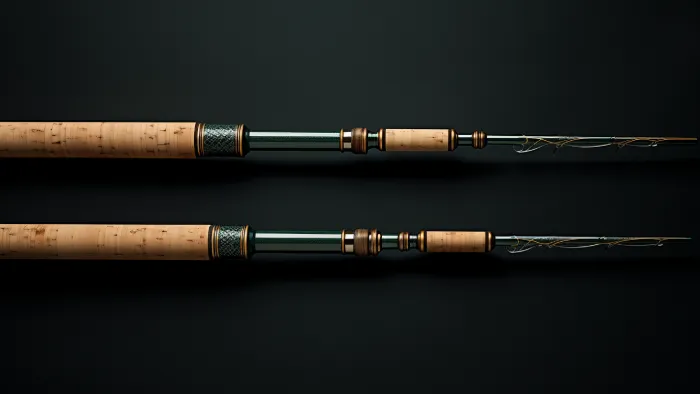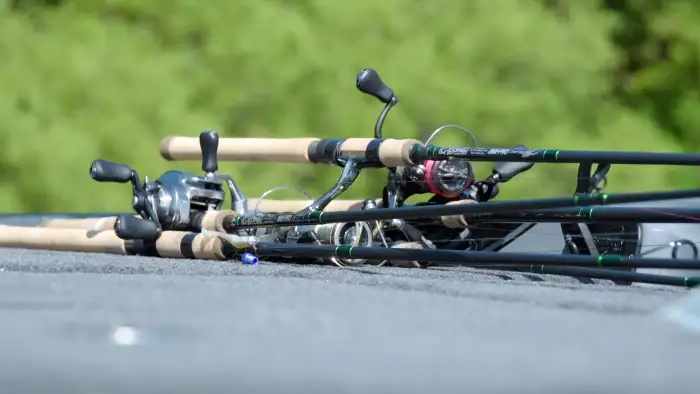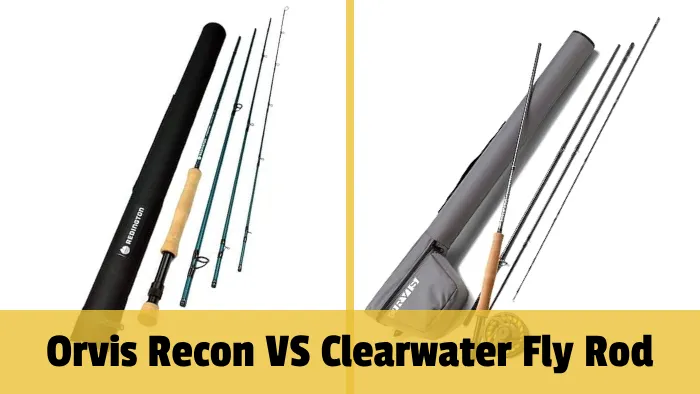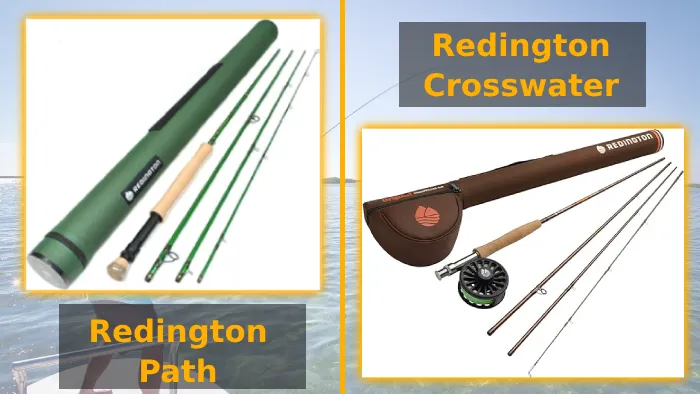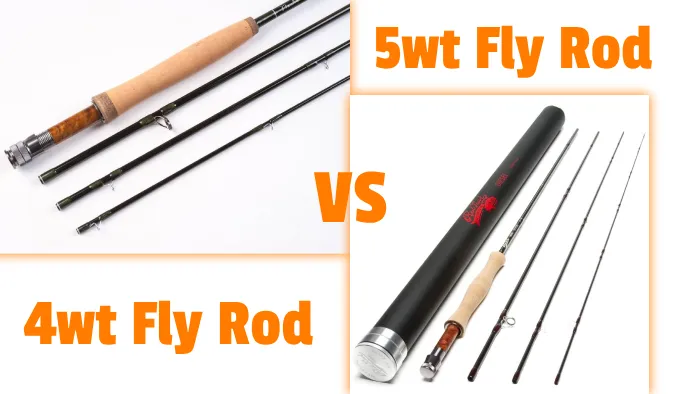How Much Weight Can a Fishing Rod Hold: Know the Truth
Fishing rods are typically made from a combination of materials such as fiberglass, graphite, or carbon fiber, which provide strength and flexibility. The rod’s guides and reel seat also affect its weight capacity. However, every fishing rod has its weight capacity and breaking strength.
You’ll be surprised that most fishing rods can hold anywhere from 10 to 25 pounds of weight. It should be noted some heavy power fishing rods can weigh a maximum of 100 pounds.
This weight capacity is determined by the materials and design of the rod. Yet, there are a lot of things that can weaken a line, like UV exposure and knots.
This article aims to provide you with a comprehensive understanding of fishing rod power ratings, breaking strength, and weight limits. So, get ready to explore the technical side of fishing rods.
What are the Power Ratings on a Fishing Rod for Holding Weight?

When considering the weight ratings on a fishing rod, make sure you understand the different categories available.
- Ultra-light rods
- Light power rods
- Medium-light rods
- Medium power rods
- Medium-heavy rods
- Heavy power rods
- Xtra heavy rods
1. Ultra-Light Rods
With an ultra-light rod, you can experience the thrill of catching smaller species with ease. These rods are specifically designed for trout, crappie, kokanee, and other smaller species fisheries. They offer a high level of bendability and action, making lighter species fun to catch.
Ultra-light rods have power ratings ranging from 1 to 4 lbs, typically indicating their ability to handle different line weights and lure sizes. The power rating of an ultra-light rod is usually denoted as UL or L on the rod itself.
These rods are designed to be highly sensitive and flexible, allowing you to detect even the slightest nibble from small fish. They’re also great for casting lightweight lures accurately and efficiently.
2. Light Power Rods
If you’re interested in light power rods, you’ll want to understand what the power ratings on a fishing rod mean. Power ratings are essential to choosing the right rod for your fishing needs.
In the case of light power rods, the power rating refers to the rod’s ability to handle a specific range of line weights and lure sizes. Light power rods are typically designed to handle line weights ranging from 4 to 8 pounds. These rods target smaller fish species such as trout, bass, or light steelhead.
3. Medium-Light Rods
Medium-light rods are the perfect bridge between light and medium-power rods. They’re commonly used for smallmouth bass fishing and steelhead offerings. While some fishing rod companies may skip this power rating, medium-light rods are highly versatile and popular among anglers.
With their power rating of 6 to 10 lbs, they can handle a decent amount of weight without compromising sensitivity. This makes them ideal for fishing when you need a balance between strength and finesse.
4. Medium Power Rods
Medium power rods are designed to handle various fishing scenarios and are suitable for targeting various fish species. They balance strength and flexibility, making them versatile tools for anglers.
These rods are commonly used for trout fishing, as they can handle fish in the 8-14 lb weight range. While slightly heavy for trout, they’re the go-to for steelhead fishing.
Medium power rods excel in finesse techniques for both smallmouth and largemouth bass. They can also handle smaller salmon species, making them a popular option for anglers targeting these fish. Some saltwater rod series also start at a medium power rating, providing lighter saltwater options for anglers.
5. Medium-Heavy Rods
You can find medium-heavy rods with power ratings ranging from 10-20 lbs, and they’re ideal for handling larger fish species. These rods balance strength and flexibility, allowing you to handle bigger fish’s increased weight and power.
With a power rating of 10-20 lbs, you can confidently target fish that weigh between 12 and 20 lbs without worrying about your rod breaking or losing control. Medium-heavy rods are commonly used in surf, saltwater, bass, and salmon fishing, as they provide the necessary strength to handle these species.
6. Heavy Power Rods
When looking for heavy power rods, you can expect them to handle weights ranging from 15 to 25 lbs so you can control and manage bigger fish. These rods are designed with a strong backbone and a lot of power to handle the weight and strength of big fish.
Heavy power rods are commonly used for musky, swimbait, salmon trolling, saltwater trolling, and live bait fishing. They provide the strength and leverage to pull hard on a fish and bring it in successfully.
7. Xtra Heavy Rods
For big presentations and big fish, an Xtra Heavy rod can handle the maximum weight required and still move a fish. These rods are designed for ultimate power and can handle weights ranging from 25 pounds to 40 pounds.
- In salmon fishing in Alaska, an Xtra Heavy rod is essential because it can hold the maximum weight and still be strong enough to move the fish.
- In saltwater fishing, these rods are perfect for targeting large species that require substantial leverage.
- In the bass world, Xtra Heavy rods are commonly used for heavy swimbait fishing or Alabama rags.
The power rating of an Xtra Heavy rod is specifically tailored to handle the demands of big presentations and big fish, making them a crucial tool for anglers seeking to tackle heavy-duty fishing situations.
What Can Affect the Breaking Strength of a Fishing Rod?

Several factors can affect a fishing rod’s breaking strength:
1. Material Composition
You should consider the material composition of a fishing rod, as it greatly affects its breaking strength. Fishing rods can be constructed using various materials, such as fiberglass, graphite, carbon fiber, and composite blends. Each material has unique properties that contribute to the overall strength of the rod.
Graphite and carbon fiber rods are renowned for their exceptional weight-carrying strength and rigidity, making them ideal for high breaking strengths. These materials have a higher modulus of elasticity, allowing them to withstand greater forces without breaking.
2. Rod Design and Construction
Rod length, taper, and blank count all play a role in determining the overall weight-carrying strength of the rod. Longer rods provide more leverage and are better suited for handling larger fish or casting longer distances. However, longer fishing rods tend to break more frequently due to their length.
3. Rod Action
Rod action plays a crucial role in determining the breaking strength of a fishing rod. When pressure is applied directly, the rod’s bend or flex affects its overall strength.
Fast-action rods, which bend mostly in the top third, tend to have a higher breaking strength than medium or slow-action rods. This is because most of the rod’s power is concentrated in the upper section, allowing it to handle heavier loads and resist breaking.
Conversely, slow-action rods bend throughout the lower two-thirds or more and have a lower breaking strength. They distribute the load over a larger area, making them more prone to breakage under heavy strain.
4. Line Strength and Type
Using a line with a higher breaking strength than your rod strength can strain the fishing rod excessively and lead to potential damage or breakage.
When selecting a fishing line, consider the rod’s recommended weight-carrying capacity, breaking strength, and the type of line being used. Different fishing lines, such as monofilament, fluorocarbon, and braided lines, have varying breaking strengths.
5. Lure or Bait Weight
To ensure the proper performance of your fishing rod, consider both the weight of the lure or bait and the recommended breaking strength of the rod.
The weight of the lure or bait can significantly impact the breaking strength required from your fishing rod. Heavier lures or baits will require a rod with a higher breaking strength to cast and control them effectively.
Using a rod with an inadequate breaking strength for a heavy lure can lead to damage or failure.
6. Care and Maintenance
To maintain the proper breaking strength of your fishing rod, you should regularly clean and inspect it to prevent any potential damage or weakening.
Cleaning your rod after each use is important to remove any dirt, salt, or debris that may have accumulated. Use a soft cloth and mild soap to gently wipe down the rod, paying attention to the guides and reel seat.
Inspecting the rod is also crucial, as small cracks or chips can weaken the structure. Look for any signs of damage, such as frayed wraps, loose guides, or missing epoxy coatings. If you notice any issues, it’s best to have them repaired by a professional or replace the rod if necessary.
7. External Factors
Certain external factors can still affect your rod’s overall durability and performance. Environmental conditions such as temperature, humidity, and exposure to saltwater can cause corrosion and weaken the rod over time.
- High temperatures can cause the rod material to expand, potentially leading to structural damage.
- Humidity can accelerate corrosion, especially if the rod isn’t properly dried before storage.
- Saltwater is particularly corrosive and can rapidly degrade the rod’s strength if not rinsed and cleaned after use.
To maintain the breaking strength of your fishing rod, store it in a cool and dry environment and rinse it thoroughly after saltwater use.
Do fishing rods have weight limits on their bodies?
When manufacturing fishing rods, they’re designed with specific weight limits marked on their bodies. These weight limits are determined by various factors, including the materials used in the construction of the rod and the intended purpose of the rod.
Most fishing rods have weight limits that range from a few ounces to several pounds. The weight limit is usually indicated on the rod through markings or labels.
Adhere to these weight limits to ensure the rod performs optimally and doesn’t become damaged or break under excessive weight. Exceeding the weight limit can put unnecessary strain on the rod and may lead to a decrease in its overall lifespan.
How to read a fishing rod’s specs from its body?
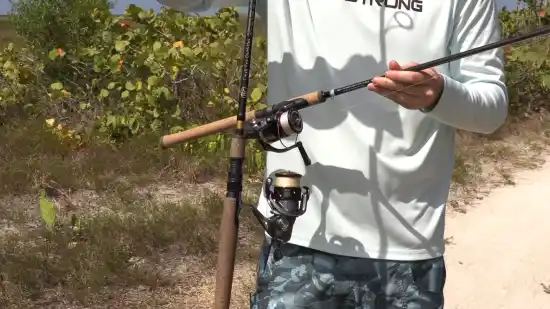
Check the first few numbers on the fishing rod’s body to determine its specifications. The first two digits of a four-digit number or three digits of a five-digit number represent the rod’s tensile strength. This number indicates the maximum pressure or force the rod can withstand without breaking.
The next-to-last digit on the rod indicates its position compatibility. A ‘1’ signifies that the rod can be used in all positions, while a ‘2’ indicates it’s suitable for flat and horizontal positions. A ‘4’ means that the rod can be used in flat, horizontal, vertical down, and above positions.
Also, the rod often mentions the line and lure weights, providing information about the recommended weights for fishing lines and lures that the rod can handle.
Will a fishing rod snap during fishing?
While it may seem sturdy, fishing rods aren’t indestructible. Over time, tiny fractures can develop in the rod, which often go unnoticed. These fractures weaken the rod’s structural integrity, making it susceptible to snapping under pressure.
It’s a common misconception that only the big fish is responsible for the rod breaking, but it’s usually the result of the accumulated damage. Factors such as excessive force, improper use, or poor maintenance can accelerate the likelihood of a fishing rod snapping.
Checking for fractures, replacing worn-out components, and storing your fishing rod properly can prolong its lifetime and minimize the risk of snapping.
Know Your Fishing Rod Weight Capacity to Maximize Fishing Success
The weight capacity of a fishing rod depends on several factors, including power ratings and breaking strength. Anglers need to understand what factors can affect how much weight their fishing rod can handle.
By doing so, they can make informed decisions about their equipment and optimize their chances of catching fish. So, consider these factors when selecting your fishing rod.
Remember, your fishing rod’s power rating and breaking strength can significantly affect your fishing trip’s success, so choose wisely. With some knowledge and dedication, you’ll be on your way to catching more fish than ever before.


